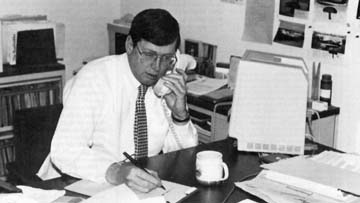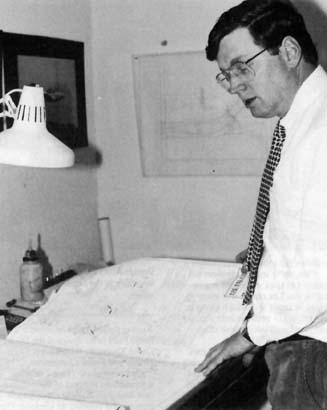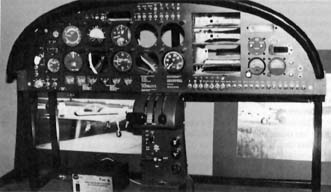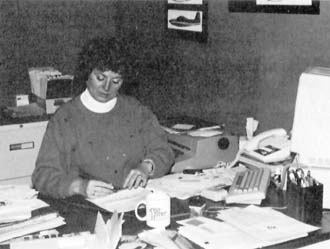Homebuilt Musings
![]()
Homebuilt Musings |
|
Kitmaker Alfred Scott chats about Falcos, quality and responsibility
by Dave Martin
This article appeared in the October 1987 issue of Kitplanes magazine. |
Alfred Scott is one of those people who, one suspects, would be outspoken and controversial in any field he undertook. What he has undertaken is to transform the classic all-wood F.8L Falco from an Italian production airplane of 1960 vintage to one of the most sensational homebuilts available now. By most measures, Scott appears to have succeeded.
My first contact with Alfred Scott came during an assignment to write about Karl Hansen's Falco, which appeared on the cover of the March 1986 KIT PLANES. A trip to Richmond, Virginia, earlier this year provided an opportunity to get to know Alfred Scott more personally.
He has tried to communicate to his Falco customers the need for a methodical approach to flight testing once the project is complete. "I try to dispel the notion of the white scarf and the brave pilot," he says. "Test pilots are people who want to live tomorrow. In the manual section on flight testing, I actually go into some gritty details about how all test pilots have buried friends and have experienced that long ride home from a memorial service with family and friends. Nobody likes to talk about dying, but I actually discuss it in the also builders' guide. I want to take this guy who has finished his airplane and is probably on a mental high. I tell him to stop and think about being around longer; I want him to approach testing with real caution.

Consulting with Falco builders is a big part of Alfred Scott's effort.
KITPLANES: Is your approach aimed at builders doing their own testing, or do you also discuss the possibility of hiring a test pilot?
SCOTT: I point out that there are two ways to make that decision. One is on emotion. The other is the logical method. By logic, the person testing the airplane should be the pilot with the most experience in the type. If you cannot visualize yourself handling the most horrible emergency you can imagine with a new airplane, then you should not be the test pilot.
The emotional decision is that you, the homebuilder, have finished the airplane and you will be the first one to fly it. That's not logical at all. I really do try to talk the builder out of doing it himself unless he really does have the pilot experience to do it.
If everything goes right on the first flight, anyone can do it.
KITPLANES: Do you provide your Falco builders with a chance to fly your own Falco?
SCOTT: Sure.
Like many of us, Alfred Scott grew up liking airplanes as a child, took lessons in his teens, soloed and ground-looped a Super Cub. "I never did anything more with it until around 1974," he says. "I got interested in hot-air balloons but decided what I really needed was an aerobatic biplane that could go cross-country at 200 mph. The compromise turned out to be a Messerschmitt Monson, which I still have. I bought the airplane and hired an instructor to teach me to fly it. I got my private pilot's license in the airplane."
Scott's Monson got him to thinking about the need for an even better airplane, and he hired David Thurston to design such an aircraft for him. The design is the Sequoia, which Scott has never finished. During the building process, he realized his interests were divided between homebuilding as a hobby and a potential homebuilt airplane business.
"I've always been something of a snob abut airplanes," Scott says, "and the first planes that really interested me were the Jungmeister and the Jungmann." He contacted a man with plans for the planes and considered establishing a plans- or kitbuilt version of the German aerobatic airplanes. After spending a year working on the project, Scott realized that he would not be able to negotiate a reasonable price for the privilege of selling plans.

Alfred Scott displays the drawings he made to convert
the Italian factory-built F.8L Falco into a kit aircraft.
At this point Scott wrote Stelio Frati, designer of the F.8L Falco. More than 100 Falcos were built by various factories in Italy.
A deal was struck, Alfred Scott bought a factory-built Falco and began to draw plans for the homebuilt version. The Falco is a wooden airplane, and Scott arranged with Trimcraft, Inc. to turn out the wooden components. Scott's Sequoia Aircraft company sells plans, materials and some finished systems to build the airplane. N either the plans nor many of the kit components were completed when Karl Hansen built his Falco. F.8L builders now have options that can cut the building time substantially.
Alfred Scott claims he's had neither engineering nor draftsman training. You would never guess looking at Scott's Falco plans that he is a Richmond, Virginia, businessman who has turned his avocation into a full-time business. The plans are as detailed and clear as any I have ever seen and include engine, instrument, electrical and hydraulic systems. (Some of the drawings, such as the electrical package, are sold as part of an optional components kit.)
My Richmond visit included staying at Alfred and Meredith Scott's Richmond home...after getting lost and stuck in a massive traffic jam exacerbated by an 18-inch snowfall the day before my arrival. Late for dinner and lost, I aimed the rental car into a residential area that had to be near the Scotts' house, then finally tramped through the snow to a large brightly lighted house to ask directions. Small children answered the bell and summoned their mother. "Alfred and Meredith Scott? Why, they live right around the block. Come in and I'll call them for you." The warmth of southern hospitality made up for the chill in the night air. Five minutes later, the snow crunched under Alfred Scott's boots as we met on the road near his helpful neighbor.
After a delicious dinner with Alfred and Meredith Scott and their two daughters, Alfred and I settled down for some philosophizing about the homebuilt airplane market. Unlike some of the sophisticated homebuilt projects, the Falco may be built from the plans only, or the builder may order any or all of the Sequoia Aircraft and Trimcraft component packages. I noted that homebuilt airplane designer Molt Taylor has expressed the opinion that kit manufacturers using this marketing technique can set themselves up for early bankruptcy. Taylor's reasoning is that once the manufacturer releases the first component kit, he is then obligated to produce all of the subsequent assemblies to finish the aircraft...without any guarantee of the number of customers who will proceed with the project and therefore will buy each of the separate kits. How does Sequoia Aircraft handle this problem? I asked.
"From a business standpoint, I think Molt Taylor is correct," Scott said. The solution, Scott believes, is that the manufacturer needs a strong following of builders who will finish their projects. "The Christen Eagle is like that," Scott notes. Component packages are sold separately, but apparently most builders who can afford an Eagle project go on to complete it. So far, Scott indicated, Falco builders fall into the same category.
"Yet, we've sold many more tail group kits than we've sold engine baffle kits," he noted. But many builders aren't far enough along in the project to need the later kits, so the jury is still out on how many complete kits will be sold.

A Falco instrument panel mockup decorates the Sequoia Aircraft office.
"The other thing I can tell you," Scott continued, "is that if Sequoia Aircraft went under tomorrow, the builders still have a complete set of plans and would be able to finish their Falcos./" Considering Karl Hansen's example and the top quality and completeness of the Falco plans, I conclude that Scott's point is valid.
But there's no indication that Sequoia Aircraft is on its way out. Alfred Scott said he had sold 480 sets of Falco plans (at $400 per set) during out talk. The number is now over 500.
In addition to plans and components, Sequoia Aircraft dispenses considerable support to the Falco builders. One example is the Falco newsletter published by Scott. As in other top-quality homebuilders' newsletters, the Falco paper is full of builder hints, first-flight reports and other useful items. "I spend about a week on each edition," Scott says. He seems to enjoy controversial topics and has included some of them in the newsletters.
In his newsletter and other forums, Scott has occasionally indicated that he is less than pleased with some of the people in the homebuilt business. "What I really respect," he said, "is quality engineering. There's really not very much good design out there." Among the designers he respects are Stelio Frati (who designed the Falco), David Thurston, John Thorp, Chris Heintz and Frank Christensen.
On composites: "I see a growing awareness on the part of the builders that fiberglass is really not a miracle material for building an airplane. The moldless composite method eliminates the need for tooling, but it is not easy," he maintains.
On new designs: "To me, the first question a potential homebuilder should ask is, 'What are the qualifications of the designer?'."
On the aviation media: "I have been disappointed with the magazines. Ten years ago, we had an aviation industry that was largely regulated by the federal government. A lot of that has gone now, and what we have is pretty much a free-for-all. When the government isn't watching, the press should be.
"Let me paint a picture of a situation. An airplane has been designed by an aeronautical engineer of moderate repute. The airplane is flying and looks pretty good, but he knows it has a stall problem. He gets a journalist to fly it with him, and they decide they're not going to stall it but will do some low-speed handling. Ten minutes later they are both dead following a spin. Yet the aviation press never mentions the accident when it writes about the airplane." The airplane was the Orion. The accident occurred in France.
Scott notes that many publications wrote about the fatal crash of one of the first homebuilt Falcos, and he does not disagree with that coverage. The airplane was flown into the ground during an instrument approach in marginal weather.

Brenda Avery keeps things moving smoothly in the Sequoia Aircraft office.
On builder modifications: "I'm always getting on the case of my builders about modifying the Falco. I will shut a builder down and have done it. I refused to sell additional parts and sent a registered letter to a builder telling him he was building an unsafe airplane. The particular builder I'm thinking of capitulated right away."
Scott talked at length about the changes he made to the kit Falco. "Minor systems in the factory-built Falcos were an abomination," he says. These systems, such as a tachometer drive that goes through a fuel tank, and a linkage that slices through part of a spar cap, were fabricated by the Italian factories, not by designer Frati. (The airplane was built successively by four different companies in Italy during its life as a production airplane.) Scott redesigned and cleaned up these anomalies, which were checked by David Thurston, the consulting engineer.
The result of the changes and the methods of production of the kit parts is ironic. Because the factory-built Falcos were built by hand in various shops, parts are not interchangeable. Yet the kit parts for the homebuilt Falcos are identical...just the opposite from what might be expected in such a comparison.
I asked whether the kit includes electrical system drawings. The electrical system kit is sold as an option that not only includes a drawing but color-coded wires and fittings and a wire-tabulation sheet that shows the routing of every wire in the system. The wiring of a Falco is complex, but the drawings and 80 page wiring manual outline every step. Everything except the battery and the landing light is included in the electrical kit.
The Sequoia Aircraft rendering of the F.8L Falco in kit form appears to mirror Alfred Scott's personality with considerable accuracy. Builders' manuals, drawings and newsletter pieces are meticulous, clever and articulate. That same personality has managed to ruffle some feathers in the aviation community; Scott's opinion and his outspoken manner have managed to alienate some people. Yet the Falco homebuilt project, which can result in the creation of one of the best sport airplanes yet, seems to have suffered not at all.
|
|